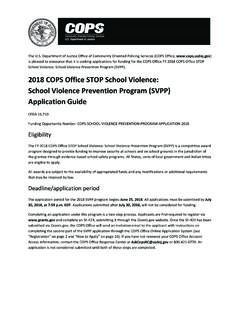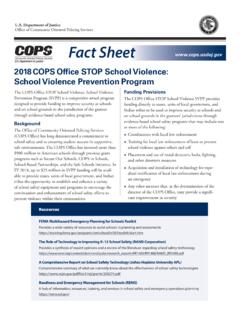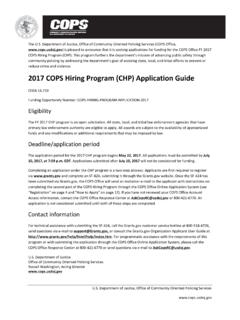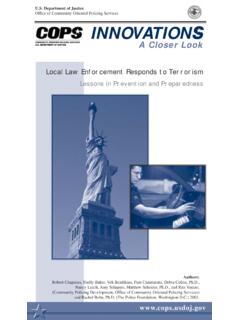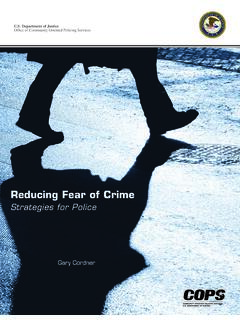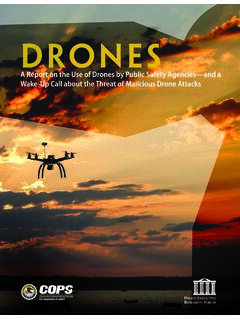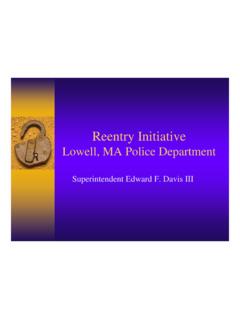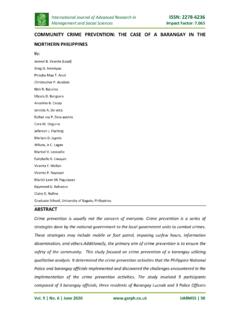Transcription of Civilian Oversight of the Police in Major Cities - COPS OFFICE
1 1 Civilian Oversight of the Police in Major CitiesDarrel W. Stephens, Ellen Scrivner, and Josie F. CambareriThis project was supported, in whole or in part, by cooperative agreement number 2015-CKWX-0024 awarded by the OFFICE of community oriented policing services , US Department of Justice. The opinions contained herein are those of the author(s) and do not necessarily represent the official position or policies of the US Department of Justice. References to specific agencies, companies, products, or services should not be considered an endorsement by the author(s) or the US Department of Justice. Rather, the references are illustrations to supplement discussion of the issues. The Internet references cited in this publication were valid as of the original date of this publication.
2 Given that URLs and websites are in constant flux, neither the author(s) nor the COPS OFFICE can vouch for their current citation: Stephens, Darrel W., Ellen Scrivner, and Josie F. Cambareri. 2018 . Civilian Oversight of the Police in Major Cities . Washington, DC: OFFICE of community oriented policing 2018 ContentsLetter from the Director of the COPS OFFICE ..vAcknowledgements .. viiIntroduction ..1 Civilian Oversight Survey..3 Prevalence of Civilian Oversight 3 Civilian Oversight model types and board characteristics4 Characteristics of Oversight bodies 10 Round Table Discussion.
3 13 Agency presentations 14 Civilian Oversight issues 20 Conclusion .. 27 References .. 29 Appendix A. Civilian Oversight Survey .. 31 Civilian Oversight of Police 31 Appendix B. Round Table Participants..35 Appendix C. Round Table Agenda .. 37 About the Major Cities Chiefs Association..39 About the COPS OFFICE .
4 40vLetter from the Director of the COPS OfficeColleagues:As you know, Civilian Oversight of law enforcement agencies is nothing new. In fact, agencies have always been accountable to the communities they serve. Moreover, additional Oversight boards have existed in various forms since the 1950s. While not present everywhere, according to Liana Perez, director of the National Association for Civilian Oversight of Law Enforcement, there are now more than 200 Oversight boards across the nation. However, like any local law enforcement initiative, Civilian Oversight takes different forms in different jurisdictions. Many agencies exploring options for their own communities often ask what others are doing to inform their own decision making.
5 To assist those agencies who want to know how Civilian Oversight is working in communities across the nation, the COPS OFFICE awarded funding to the Major Cities Chiefs Association (MCCA) to survey its members and hold a round table to discuss the results. The round table participants, who represented 21 agencies in Canada as well as the United States, talked about how Civilian Oversight worked in their own communities. They described the objectives of their Oversight programs and debated their advantages, challenges, and effectiveness, calling attention to issues they felt were especially important for their peers to behalf of the COPS OFFICE , I thank the MCCA and its members who responded to the survey, as well as the 21 round table participants, all of whom generously gave of their time and forthrightly expressed their opinions.
6 Our thanks also go out to the National Law Enforcement Memorial Fund, which hosted the meeting. This report provides an overview of the existing landscape in local Oversight . It is important to share this with the field as law enforcement agencies throughout the nation work to continue to build and maintain trust, ensure the quality of the services they deliver, and enhance their mechanisms for local accountability and control that are so important to effectively policing our nation s many and varied communities. The COPS OFFICE is proud to be able to support local agencies in making informed decisions for their ,Phil Keith Director OFFICE of community oriented policing ServicesviiAcknowledgementsThe authors would like to acknowledge the important contributions made to this project by members of the Major Cities Chiefs Association that responded to our membership survey on their Civilian Oversight models and for participating in the round table discussion.
7 We are also grateful for the participation of President Brian Corr and Vice President Margo Frazier from the National Association of Civilian Oversight of Law Enforcement in the round table discussion. MCCA Associate Director Patricia Williams made an important contribution through handling the administrative and logistical aspects of the project. 1 IntroductionCivilian Oversight of the Police has been a topic of discussion and debate since the 1960s. The debate generally surfaces in communities where there has been a high-profile incident in which a member of the community has been injured or killed during an encounter with the Police . The shooting death of Michael Brown in Ferguson, Missouri, in August 2014 followed by other high-profile shootings and deaths pushed Civilian Oversight and Police accountability into the national spotlight.
8 Although not generally acknowledged by the public, Police agencies have always had Civilian Oversight through elected mayors, city councils, prosecutors offices, court decisions, and state and federal legislation. Since the early 1960s, other forms of Oversight have been developed in the hope of ensuring greater Police accountability and community trust. In the earliest cases, a number of Cities established Civilian Police commissions or boards (Los Angeles; Chicago; Kansas City, Missouri; and Detroit are examples) that played a role in the selection of the chief, policy development, and discipline. Since the late 1960s, other forms of Civilian Oversight have emerged. A number of Civilian Oversight classification systems developed over the years because of the wide variation in approaches adopted by communities.
9 The National Association of Civilian Oversight of Law Enforcement (NACOLE) adopted a system developed by Samuel Walker in 2001 with some modifications of their NACOLE places Civilian Oversight bodies in one of three classifications:1. The investigation-focused model involves routine, independent investigations of complaints against Police officers, which may replace or duplicate Police internal affairs processes, though non- Police Civilian investigators staff The review-focused model concentrates on commenting on completed investigations after reviewing the quality of Police internal affairs investigations. Recommendations may be made to Police executives regarding findings, or there may be a request that further investigations be conducted.
10 A review board composed of citizen volunteers commonly heads this model, and they may hold public meetings to collect community input and facilitate Police - community The auditor/monitor model focuses on examining broad patterns in complaint investigations including patterns in the quality of investigations, findings, and discipline rendered. Further, in some Cities that use this model, auditor/monitors may actively participate in or monitor open internal investigations. This model often seeks to promote broad organizational change by conducting systematic reviews of Police policies, practices or training, and making recommendations for De Angelis, Rosenthal, and Buchner, Civilian Oversight Civilian Oversight of the Police in Major Cities2 Civilian Oversight programs vary significantly from one city to the next and even within the general categories described here, and in some communities there are aspects of all of the models.
